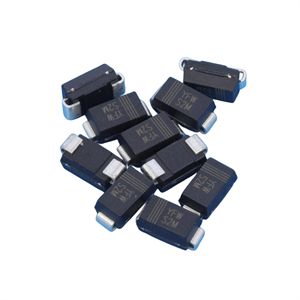Date:2024-09-23 Categories:Product knowledge Hits:429 From: Guangdong Youfeng Microelectronics Co., Ltd(YFW)
Schottky diodes are widely used for their fast switching response, low forward voltage drop, and high efficiency, especially in low-voltage, high-frequency power conversion and rectification applications. However, in order to fully utilize the performance of Schottky diodes while avoiding potential issues.
Consideration of forward pressure drop (Vf)
A significant feature of Schottky diodes is their low forward voltage drop, which means they consume less power when conducting, thereby improving the overall efficiency of the circuit. However, the forward voltage drop decreases with increasing temperature, which may lead to an increase in current in high-temperature working environments. Therefore, heat dissipation measures need to be considered in the design to ensure that the diode will not be damaged due to overheating.
Reverse leakage current (Ir)
The reverse leakage current of Schottky diodes is usually higher than that of traditional PN junction diodes and significantly increases with temperature. In high-temperature applications, high leakage current may lead to increased power loss and even affect the stability of the circuit. Therefore, when choosing Schottky diodes, appropriate models should be selected based on the temperature range of the application environment, and appropriate heat dissipation measures should be considered.
Maximum reverse voltage (Vr)
The maximum reverse voltage of Schottky diodes is usually lower than that of traditional diodes, which limits their use in high-voltage applications. When designing, it is necessary to ensure that the maximum reverse voltage of the diode is higher than the maximum voltage that may occur in the circuit to avoid damage due to exceeding its reverse voltage rating. For high-voltage applications, other types of diodes may need to be considered.
switching frequency
Schottky diodes are widely used in high-frequency power conversion due to their fast switching characteristics. However, at extremely high frequencies, parasitic parameters inside the diode, such as parasitic capacitance and parasitic inductance, may affect its performance. Designers need to consider these parasitic effects, which may be mitigated through circuit design optimization.
temperature characteristic
Due to the significant influence of temperature on the characteristics of Schottky diodes, including reduced forward voltage drop and increased reverse leakage current, special attention should be paid to the impact of temperature on performance during design. In addition to selecting appropriate models and specifications, it may also be necessary to consider adding temperature compensation mechanisms or optimizing heat dissipation design to ensure stable operation of the circuit throughout the entire operating temperature range.
Electromagnetic Compatibility (EMC)
The fast switching characteristics of Schottky diodes may generate high electromagnetic interference (EMI), especially in high-frequency applications. Appropriate filtering and shielding measures should be considered during design to reduce the impact of EMI on other parts of the circuit and surrounding equipment.
Schottky diodes play an important role in modern electronic circuit design due to their unique performance characteristics. However, in order to maximize its performance and ensure the reliability and stability of the circuit, designers need to carefully consider the various factors mentioned above.

Previous: Classification, Structure, and Principle of MOSFET
Next: Why does transient suppression diode have residual voltage? How did it come about?